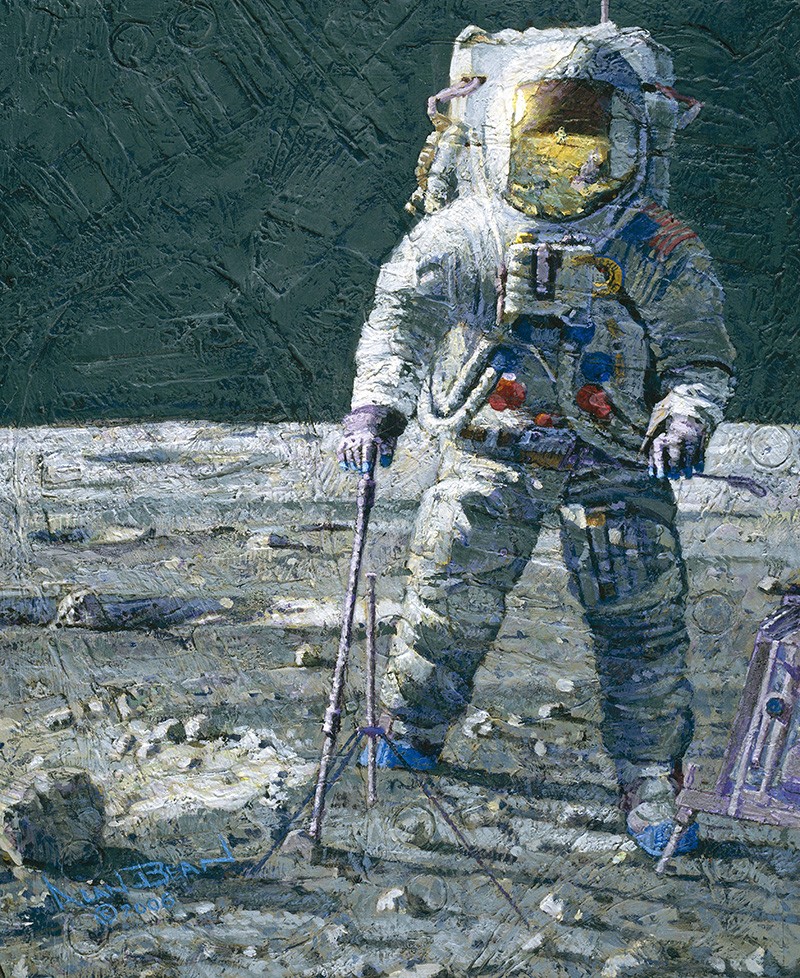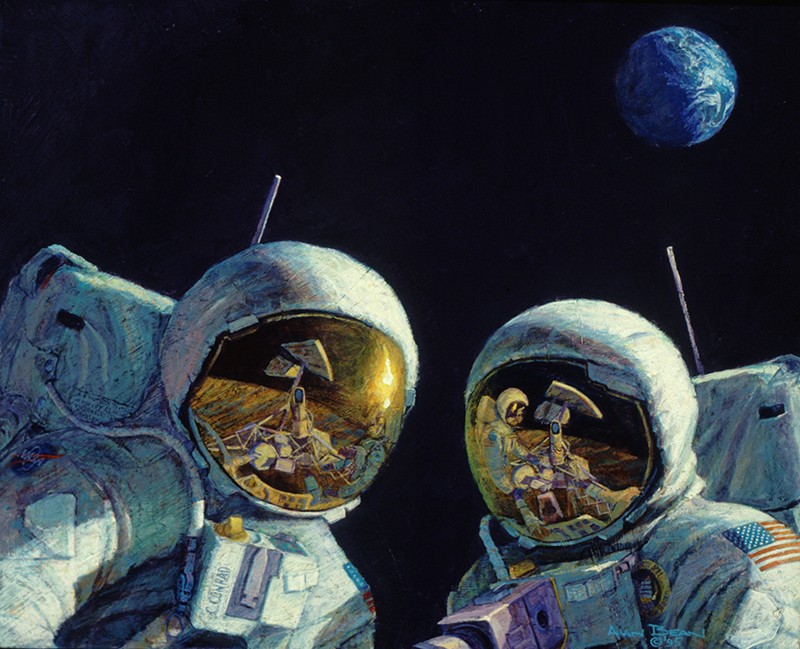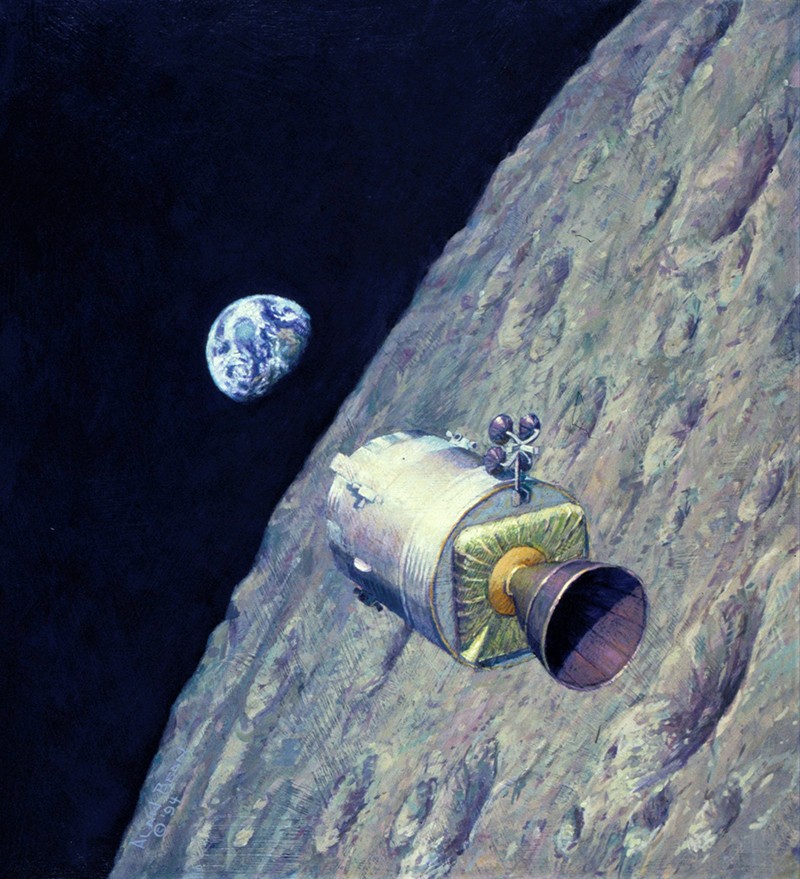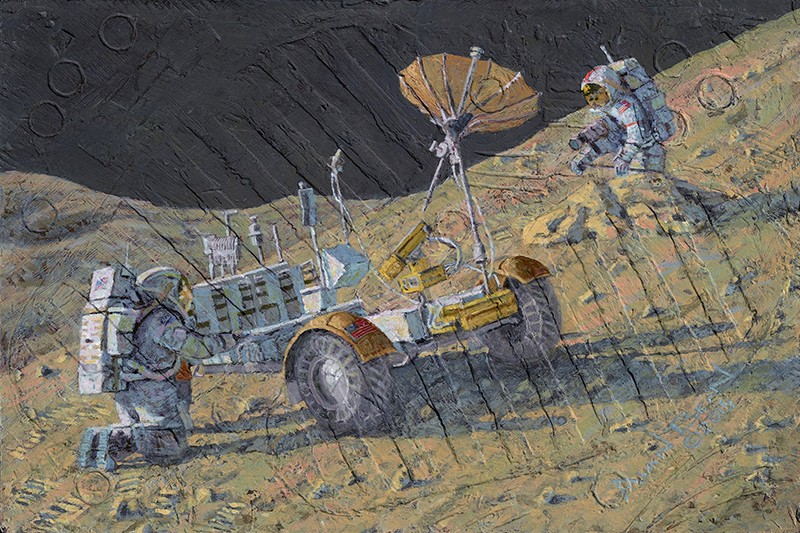(원문)
Richard Taylor pays tribute to the Apollo astronaut who beautifully meshed science and art.
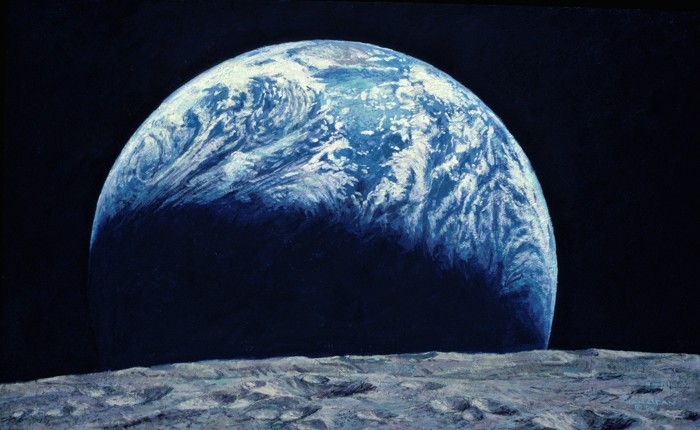
Apollo 12 astronaut Alan Bean’s 1994 painting Kissing the Earth was inspired by the view as he and his team began their descent to the Moon in 1969.
In November 1969, when I was six years old, my father pointed to the Moon and told me that a man was walking on it. I looked up at the silver sphere and wondered what he was doing up there in that remote, crater-riddled land. I later learned that his name was Alan Bean, and that he was the fourth of only 12 humans so far to walk on another world. Even in that select group, he was unique: he was the only one to record what he saw on canvas and in paint. In May, he died at the age of 86.
As my interest in space travel grew, I read about the trajectory that led Bean to his Apollo 12 Moon landing. Earning an aeronautical-engineering degree from the University of Texas at Austin in 1955, he soon achieved his childhood dream of becoming a Navy test pilot. His instructor was Pete Conrad, later a fellow member of the Apollo 12 mission and Moon-walker, who became his closest friend. Inspired by the “sights, sounds and smells of high performance flying machines”, as Bean put it, they hatched their plan to ride the biggest flying machine of them all.
Astronauta Optimus Maximus (2006) depicts Bean’s friend and Apollo 12 commander Pete Conrad. There is Moon dust mixed into the paint.Credit: Courtesy of the Alan Bean Gallery
Standing 110 metres tall, the Saturn V remains the most powerful rocket ever flown. Four months before the Apollo 12 launch, one of these behemoths had carried Neil Armstrong and his crew to the first Moon landing. But whereas Armstrong took off on a sweltering summer’s day, Bean, Conrad and fellow astronaut Richard Gordon sat on their rocket engulfed by a winter thunderstorm. Thirty-six seconds into their launch, the unthinkable happened. The Saturn V was struck by lightning — twice. “I looked up at the display that had all of the caution lights and there were more on than I’d ever seen in my life,” Bean recalled. Seconds away from aborting the mission, he managed to reboot the affected systems. The astronauts’ nervous laughter could be heard all the way to orbit.
Previous astronauts behaved with reserve. Bean gave the public a glimpse of the more human side of being a space explorer. Armstrong commenced his historic landing with a deadpan “See you later”, descending to the Moon’s surface in tension-building silence. Bean sounded like an excited tourist. His commentary seemed to touch on whatever popped into his mind: from the view outside his window (“Looks good out there, babe, looks good”) to the relief of seeing his landing spot in the Ocean of Storms (“There’s that crater right where it’s supposed to be”), to complementing Conrad on his flying skills (“You’re beautiful”).
Please Take Me Back Home, Guys (1995) imagines the point of view of lunar lander Surveyor III.Credit: Courtesy of the Alan Bean Gallery
Once Bean had ignited my six-year-old imagination, I was on my way into the life scientific. I drew make-believe planets, the real Solar System, spaceships and alien cityscapes — even how aliens might play cricket without gravity. By 1984, close to finishing my physics undergraduate degree, I was — like him — grappling with competing desires to pursue science and art.
Meanwhile, the world was busy celebrating the 15th anniversary of the first Moon landing. Television screens were flooded with Apollo astronauts reminiscing about their epic journeys. Seeing the blue Earth hanging like an oasis in the inky darkness filled many of them with a deep spiritual connection to the Universe. Bean, more down-to-Earth, appreciated all that the Moon lacked. “Since that time I have not complained about the weather a single time … I’ve not complained about traffic,” he said. “When I got back home, I’d go down to shopping centres and … just watch the people go by and think, ‘Boy, we’re lucky to be here.’”
The Apollo 8 craft begins its return to Earth in Homeward Bound (1994).Credit: Courtesy of the Alan Bean Gallery
Bean’s scientific legacy is fascinating. He brought back a Moon rock known as KREEP (potassium, rare-earth elements, phosphorus). Its composition led to a new model of lunar formation: the giant-impact hypothesis. Still being refined by current research, this pictures the Moon forming during violent collisions between Earth and one or more planet-sized objects.
Bean flew once more for NASA, in 1973: he spent a record-breaking 59 days orbiting Earth as commander of the space-station mission Skylab 3. In 1981, he left the agency to work out how best to tell his story to the world. How could he describe what it was like to hurtle home at 40,000 kilometres per hour, or to place his thumb in front of Earth and block from view everything he knew? He found his answer in painting. He even mixed Moon dust into his acrylics, and used his Apollo hammer and boots to, in his words, “sculpt a textured surface unique in all of art history”. (Many of Bean’s works are reproduced in his 2009 book Painting Apollo: First Artist on Another World.)
Apollo 15 astronauts Dave Scott and Jim Irwin wrangle their Lunar Rover in Slip Slidin’ Away (2015). The paint was textured using Bean’s Apollo boots.Credit: Courtesy of the Alan Bean Gallery
Bean’s art is important in other ways. Apollo 8 astronaut Bill Anders’s stunning photograph Earthrise, taken from lunar orbit, is rightly viewed as iconic. But Bean’s art goes further: it adds emotion to the extraordinary scenes he witnessed. Self-described as one of the more fearful astronauts, he was well aware that death was always near. That comes through in his paintings. Whether we see astronauts deploying equipment, the Service Module flying across the lunar surface, or Earth peeking above the horizon, there’s a feeling of being far from home — in terms of both distance and difficulty. The loneliness in these works reminds me of Frank Hurley’s photographs of Ernest Shackleton’s epic 1914–17 journey to the Antarctic.
Above all, Bean’s paintings serve as an antidote to that foolish idea that emerged in the 1980s: that our brains are wired to be either artistic or scientific. Inspired by his example, I went on to be a professor of both art and science. He showed that it was a simple matter. You just follow your dreams.
Alan Bean at an exhibition of his work and the National Air and Space Museum in 2009.Credit: Michael Temchine/TWP/Getty
